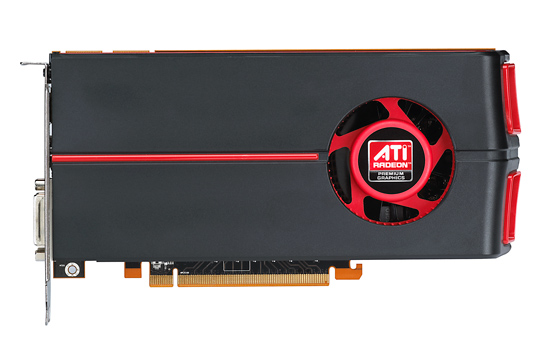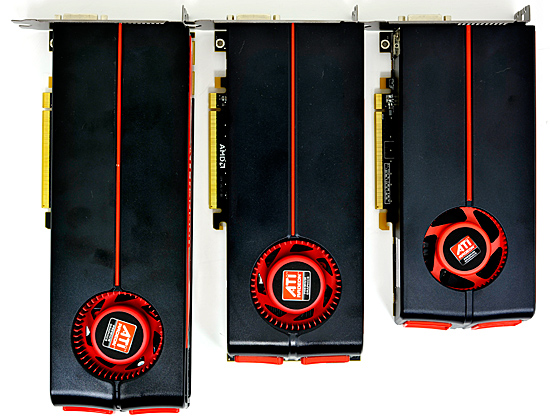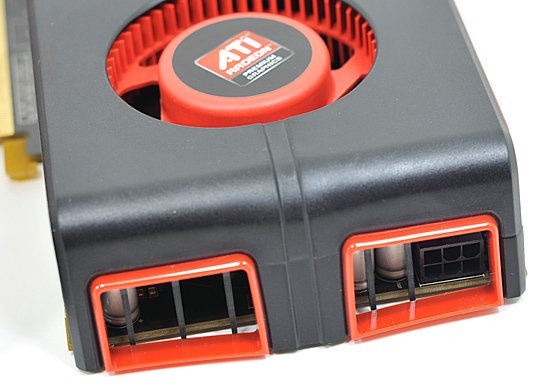AMD’s Radeon HD 5770 & 5750: DirectX 11 for the Mainstream Crowd
by Ryan Smith on October 13, 2009 12:00 AM EST- Posted in
- GPUs
Meet The 5770
We’ll start our look at today’s cards with the 5770. As we mentioned previously the 5770 is the full speed Juniper card, with all 10 SIMDs enabled, and clocked at 850MHz for the core and 1.2Ghz (4.8GHz data rate) GDDR5 for the RAM. As has become the current standard for just about every card over $100 these days, the card is equipped with 1GB of RAM. Attaching this RAM to the GPU is a 128-bit bus, giving the card 76.8GB/sec of memory bandwidth. The use of such fast RAM strikes our interest in particular, since it means vendors are spending just as much to equip a 5770 with RAM as they are a 5870.

For cooling, the 5770 uses the same general plastic shroud as the 5800 series cards, which AMD’s 5700 team told us is called the Phoenix. Here the shroud hangs over the rear of the card by just less than half an inch, making it more like the 5870 than the 5850 where the shroud stopped at the edge of the card. The length of the card is 8.25”, adding the shroud brings it to just shy of 8.75”.

5870, 5850, 5770
Interestingly enough, we’ve been told that the Phoenix shroud isn’t going to be sticking around for long. The first wave of cards launching today and for the near future will be using the shroud, but once AMD’s vendors begin using their own designs, AMD doesn’t expect most of the vendors to stick with the shroud. XFX has specifically been named as a party that will keep using the shroud on products, but anyone else is subject to change. With a TDP of only 108W, the Phoenix shroud is probably overbuilt and certainly more expensive than vendors would like, where mainstream products come with thinner margins. We would expect the vendors that do switch to move to more traditional dual-slot coolers, likely ones that aren’t shrouded at all and would not blow hot air outside of the case.
While we were fine with the shroud on the 5800 series, we do take slight issue with it on the 5770. Because the single 6-pin PCIe power connector on this card is on the rear of the card, the shroud is in the way of the PCIe power connector. This wasn’t an issue on the 5870 since the power connectors were on top, and on the 5850 the shroud stopped at the end of the card. But here the extra shroud makes it much harder to see what you’re doing when it comes to plugging in a PCIe power connector unless you’re looking at the rear of the card, and it makes it a bit harder to remove a PCIe power plug once placed.

AMD made it clear to us that they did consider this in the design of the 5770, and to their credit the shroud never makes inserting/removing a PCIe power plug impossible, but that doesn’t mean we have to like it. We would have liked to see the shroud go the same length as the card, so that it would be just as easy to use as the 5850.
At any rate, along with keeping the 5800 series shroud, the 5770 keeps the port configuration. 1 DisplayPort, 1 HDMI port, and 2 DVI ports make up the card’s output options. This is intentional on the part of AMD, as they want to push Eyefinity on these cards just as much as they do on their high-end products, which means they want to use the same ideal configuration. We wouldn’t be shocked to see this modified at the same time as vendors dropping the shroud though; 1 DVI, 1 HDMI, and 1 DisplayPort with a flexible HDMI->DVI adapter is a likely configuration.

The price of DisplayPort->DVI dongles rears its head once again here, and even more severely. DisplayPort monitors are still rare, so the most likely Eyefinity configuration is going to be 3x DVI, which is going to require a dongle. Those dongles are still going for $100+ right now, which is a significant fraction of the price of the card itself. We talked to AMD about this issue, but it’s something that’s out of their hands for the moment.
AMD is pricing this card at $159. This puts it in competition with the cheapest GTX 260s from NVIDIA, and AMD’s 4870, the latter of which tends to sell for only $10 less for the 1GB version. AMD wouldn’t give us a clear idea on how long they expect the 4870 to last, but it seems clear that they intend to phase out the 4870 with the 5770. This may not be such a great idea, but we’ll get to that after we take a look at performance.
Notably, this leaves a $100 pricing hole in AMD’s 5000-series product lineup, since the next card up is the $259 5850. AMD pointed out to us that this is by no means unprecedented (the 4800 series launch saw a $100 gap between the 4870 and 4850) but we’re not used to seeing such a gap in recent times. This price gap makes a little more sense with AMD’s target demographics: the 5800 series is for 2560x1600 gaming, while the 5770 is targeted for 1920x1200/1080. So as far as they’re concerned, there isn’t a demographic gap to make the price gap a problem.
Anyhow, for the time being, the 4890 will function as a slight bridge on that pricing gap. It will continue to occupy a range around $180-$200.
For today’s launch, availability is expected to be in the “tens of thousands” of units. We suspect that the situation is going to mirror the 5870 launch (tight availability at first) but we’ll see. For this launch period, AMD is also extending the DIRT 2 freebie offer to vendors that want to include it with their 5770 cards. So most if not all cards will come with a voucher for this game to get it in December.










117 Comments
View All Comments
flipmode - Tuesday, October 13, 2009 - link
What in the world is going on with this game? 8800 GT beats the 4850? No, sorry, I don't buy that. Something is wrong here. The 5770 beats everything? If that is the case, then this game should immediately be removed from the bench suite - games in the bench suite should help us understand the general performance characteristics of the hardware and a game that returns such erratic results actually distorts that understanding.Griswold - Tuesday, October 13, 2009 - link
On page 13 you say:"The 3870 beats it by 14W at the cost of a significant degree of performance, while the 8800GT is neck-and-neck with the 4770, again with a decent-sized performance gap."
You certainly meant 5770 there. But this brings me to a question: Why isnt the 4770 included here? As an owner of that card, I'm very much interested in the performance/power/noise difference - just ditch one of the relatively irrelevant SLI or CF combos. I dont think too many care about comparing high-end multi-GPU with performance parts such as the 5770 and 5750, even if its 57xx in CF.
flipmode - Tuesday, October 13, 2009 - link
Ryan - thanks so much for the review. Nice job. It does seem like a 5750 Crossfire would be an interesting value - moreso than the 5770 since the latter is overpriced.And, Anand, I love your site, and don't take this personally, but, PLEASE GET A COMMENT SYSTEM THAT DOES NOT TOTALLY SUCK!
Check out TechReport for an example of the awesomest comment system in the universe.
PLEASE!
Ryan Smith - Tuesday, October 13, 2009 - link
AMD only sent out 1 5750, so I don't have a second one to Crossfire at this time.Roland00 - Tuesday, October 13, 2009 - link
It makes no sense (beside bad drivers) for the 5770 to lose to the 4850. The 5770 has more memory bandwidth (76.8) compared to the 4850 (63.55 gb/s), due to the 4850 sticking with ddr3, even with the 128 bit bus. The 5770 is also clocked 36% faster than the 4850 (850 vs 625).Yet the 5770 underpeforms the 4850 being almost tied?
Zool - Tuesday, October 13, 2009 - link
Maybe the 4*64bit memmory controlers on the perimeter of the chip keep up the data better than 2*64bit controlers with higher bandwith.I think that they could make it at least 192 bit (3*64bit).
Zool - Tuesday, October 13, 2009 - link
Actualy where the hell are the Cypress and Juniper die shots ?I cant find a single one on net.
Ryan Smith - Tuesday, October 13, 2009 - link
AMD is not releasing die shots.dgz - Tuesday, October 13, 2009 - link
Looks to me like AMD is trying to lure people into buying the remaining 48** cards. Once the old chips are cleared, the price of 57** will no doubt drop.GrizzlyAdams - Tuesday, October 13, 2009 - link
What really has me concerned is how the 5870 is scaling in these tests.The 5870 core is essentially two 5770s strapped together, and you would hope scaling would be near linear. When two 5770s in crossfire match or even beat a 5870 I'm left scratching my head.
Somewhere there is a significant bottleneck in the 5870's design, and I'm wondering where that is. Anyone have any clue?
Hopefully a driver update will fix these issues, because if not there is a lot of wasted silicon on each of these chips...